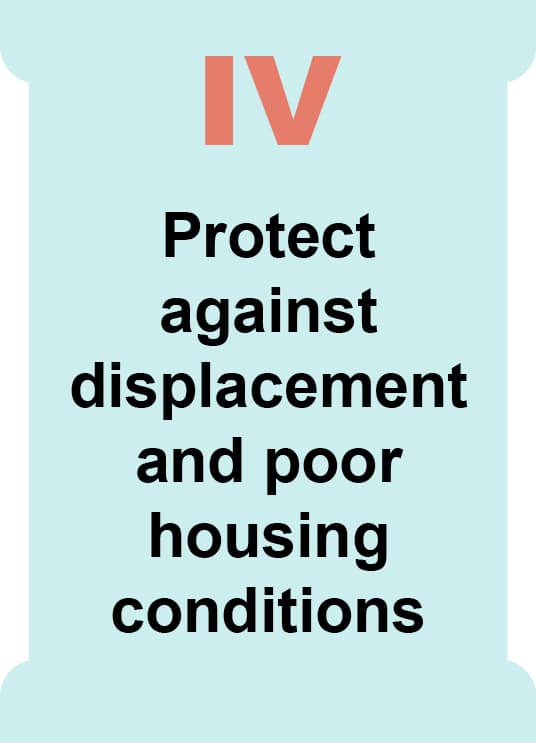2.3 Selecting Policies
How Should Localities Select Housing Policies for Inclusion in a Strategy?
To meet their housing policy objectives, most localities will need a range of different housing policies. The need for a multi-pronged strategy is driven both by the complexity of the housing market and the fact that most localities have multiple housing policy objectives. For example, a locality may wish to simultaneously achieve all these policy objectives:
- Prevent and reduce homelessness
- Expand housing affordability for low- and moderate-income renters
- Increase homeownership opportunities for first-time buyers
- Prevent evictions and foreclosures to improve residential stability
- Prevent the displacement of long-time residents in neighborhoods with rapidly rising rents
- Facilitate aging in place by older adults
A key first step in selecting housing policies for a housing strategy is to identify and prioritize the housing policy objectives that the locality seeks to achieve. This section begins by providing some guidance on how to do this.
The second part of this section introduces the Local Housing Solutions Policy Framework, which provides a conceptual framework to help localities understand the full array of local housing policy options and facilitates the development of strategies that are comprehensive and balanced, two important attributes of an effective local housing strategy.
How can localities identify and prioritize their housing policy objectives?
Affordability, homelessness, and special populations
- Increasing the affordability of rental housing
- Meeting the housing and services needs of older adults and people with disabilities
- Preserving market affordable rental housing
- Preserving the existing stock of dedicated affordable rental housing
- Reducing homelessness and meeting the emergency needs of individuals and families experiencing homelessness
Homeownership
Stability, quality, and safety
Inclusion
Community development
Energy and transportation
Health and education
The Importance of Comprehensiveness and Balance
It’s important for a local housing strategy to include policies that address its housing challenges and advance its housing policy objectives, but it must also be comprehensive and balanced. We discuss those terms and how to achieve them in this section. To begin, click on each of the questions below to learn about comprehensiveness and balance.
Because the housing challenges most jurisdictions face are multifaceted, they benefit from being addressed through multiple approaches and tools. A comprehensive local housing strategy combines different types of tools (e.g., subsidies, tax incentives, zoning incentives, and permitting reforms) that fall within the jurisdiction of various agencies (e.g., local housing department, public housing authority, local tax authority, planning department, and zoning commission).
A balanced local housing strategy addresses different dimensions of housing policy to meet the full range of a jurisdiction’s needs. For example, it both:
- Creates and preserves dedicated affordable housing AND increases the overall supply
- Helps residents rent AND own homes
- Expands resources in low-income areas AND develops affordable housing in resource-rich areas
- Protects residents from displacement WHILE accommodating growth
Four Pillars of a Comprehensive, Balanced Local Housing Strategy
Watch this video about the LHS Policy Framework
This graphic illustrates the four main pillars of the housing strategy. Click on any of the pillars, or the box on complementary policies, for an overview of what it covers.


Policies in the first pillar help create and preserve dedicated affordable housing units, which come with legal restrictions on the rents, home prices, or incomes of future occupants. Among others, the policies in this pillar include funding strategies that generate revenue to support new development or preservation, and incentives or requirements for new development to include affordable units.
General obligation bonds are one strategy that can be used to generate funding to support dedicated affordable housing. In 2019, for example, residents of Durham, NC, voted in favor of a $95 million affordable housing bond to fund the Affordable Housing Bond Investment Plan. The plan will help create new dedicated affordable housing units and preserve affordable rental units and advance goals under other policy pillars, including policies related to homelessness, homeownership, and residential stability. The additional housing financed is projected to increase Durham’s affordable housing stock by at least a third and create nearly 3,000 jobs.




Complementary Policies – Housing policies can have an impact on outcomes in many other social policy domains, including health, education, transportation, and environmental sustainability, among others. Expanding a locality’s strategy to include policies at the intersection of housing and one or more of these other domains can help the locality more intentionally take advantage of this synergy and expand the base of support for the locality’s housing strategy.
The Local Housing Solutions team recommends that, at a minimum, each locality’s housing strategy include at least one policy corresponding to each of these four pillars. Larger cities should consider including at least one policy corresponding to each of the subcategories within each pillar, which correspond to the key functions served by different groups of policies within the pillar.
For example, within the first pillar, Create and preserve dedicated affordable housing units, there are seven sub-categories, including “generating revenue for affordable housing,” “supporting affordable housing through subsidies,” and “preserving existing affordable housing.”
Part 3 of this training discusses each of the Policy Framework pillars in more detail, followed by a section on complementary policies where housing and other social policies intersect/overlap.